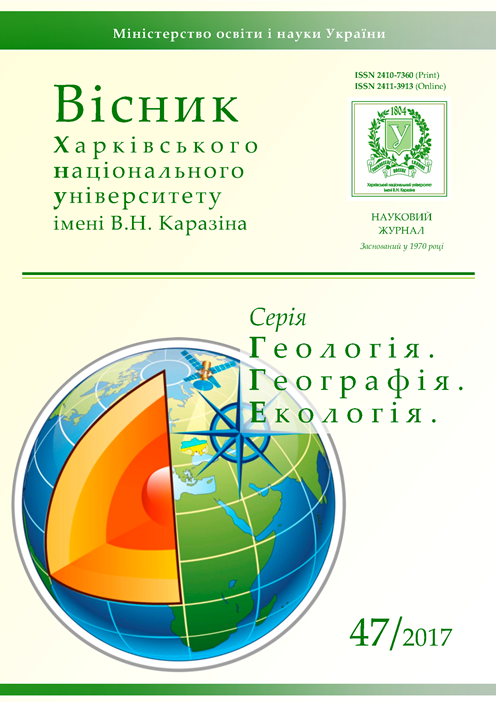Вирішення задачі пошуку придатної ділянки міста за допомогою просторового аналізу
Анотація
В статті подається один із варіантів вирішення типової задачі пошуку оптимального місцеположення для нового об’єкта, базуючись на наборі факторів, в середовищі ГІС (на прикладі пошуку придатної ділянки для побудови нової школи поруч з парками, дитячими майданчиками, на відстані від інших шкіл та кладовищ). Коротко характеризуються складнощі, з якими стикаються дослідники міст та інфраструктури. Описується загальний алгоритм виконання просторового аналізу, який включає моделювання явищ та процесів. Розглядаються 5 етапів вирішення аналітичної просторової задачі, які включають постановку задачі, розділення її на окремі складові, вивчення вихідних даних, виконання аналізу та перевірку отриманих результатів. Наводиться приклад послідовності дій, необхідних для перекласифікації даних з метою обрахунку відносного показника. Описані окремі інструменти платформи ArcGIS та можливості їх застосування для цілей просторового аналізу. Подаються можливості подальшого ускладнення логіки моделювання за рахунок більшого комбінування вхідних даних, що надає змогу отримувати максимально корисну інформацію.
Завантаження
Посилання
2. Зейлер, М. Моделирование Нашего Мира. Пособие ESRI по проектированию баз геоданных / М. Зейлер. – Киев : ECOMM Co, 2004. – 254 c.
3. Костріков, С. В. Геоінформаційне моделювання природно-антропогенного довкілля. Наукова монографія / С. В. Костріков // Харків : Вид-во ХНУ ім. В. Н. Каразіна. – 2014. – С. 484.
4. Костріков, С. В. Дворівнева ГІС-модель для аналізу урбогеосистем / С. В. Костріков, О. С. Чуєв // Регіон – 2015 : Стратегія оптимального розвитку : Матеріали міжнародної науково-практичної конференції. – Харків. – 2015. – С. 20-22.
5. Костріков, С. В. Програмне забезпечення ГІС для LiDAR-технології дистанційного зондування в цілях аналізу урбогеосистем / С. В. Костріков, Д. Л. Кулаков, К. Ю. Сегіда // Проблеми безперервної географічної освіти і картографії. – 2014. – Вип. 19. – С. 45-52.
6. Лихачева, Э. А. Город – экосистема / Э. А. Лихачева, Д. А. Тимофеев, М. П. Жидков и др. – М. : ИГРАН, 1996. – 336 с.
7. Мєзенцев, К. В. Урбанізовані території України : причини і наслідки трансформації у пострадянський пері-од / К. В. Мєзенцев // Берегове : Вид-во Закарпатського угорського інституту ім. Ф. Ракоці. – 2012. – С. 310-317.
8. Офіційний сайт електронного довідника 2ГІС. [Електронний ресурс]. – Режим доступа :: https://2gis.ua
9. Тикунов, В. С. Моделирование в социально-экономической географии / В. С. Тикунов – М. : Изд-во МГУ, 2005. – 280 с.
10. Чуєв, О. С. Використання електронного довідника 2ГІС та ГІС-платформи ArcGIS для дослідження інфра-структури міста / О. С. Чуєв, С. В. Костріков // Вістник Херсонського державного університеу, серія «Гео-графічні науки». – Вип. 7. – Херсон : Видавництво ХДУ. – 2017. – С. 52-62.
11. Чуєв, О. С. Оцінка через ГІС-заоби просторової диференціації благоустрою міста як функції урбогеосис-теми (на прикладі м. Харків) / О. С. Чуєв, С. В. Костріков // Часопис соціально-економічної географії. – Вип. 18(1). – Харків : Видавництво ХНУ. – 2015. – С. 52-62.
12. Bailey, T. A Review of Statistical Spatial Analysis in Geographical Information Systems / T. Bailey, S. Fotheringham, P. Rogerson eds. // Spatial Analysis and GIS. Taylor & Francis. – London. – 1994. – P.13-44.
13. Berkowitz, A. R. Understanding Urban Ecosystems : A New Frontier for Science and Education / A. R. Berkowitz, C. H. Nilon, K. S. Hollweg eds. – New York : Springer-Verlag, 2005. – 523 p.
14. Bourne, L. S. Polarities of Structure and Change in Urban Systems : A Canadian Example / L. S. Bourne // Geo-journal. – 1997. – Vol. 43. – P. 339–349.
15. Bourne, L. S. Systems of Cities : Readings on Structure, Growth, and Policy / L. S. Bourne, J. W. Simmons (Editors) – Oxford : Oxford University Press, 1978. – 565 p.
16. Boyce, D. Forecasting Urban Travel : Past, Present and Future / D. Boyce, H. Williams. – Cheltenham – Northhampton : EE Publishing, 2015. – 639 p.
17. Coffey, W. J. Factors and Correlates of Employment Growth in the Canadian Urban System, 1971-1991 / W.J. Coffey, R. G. Shearmur // Growth and Change. – 1998. – Vol. 29. – P. 44-66.
18. Goodchild, M. F. Towards a general theory of geographic representation in GIS / M. F. Goodchild, M. Yuan, T. J. Cova // International Journal of Geographical Information Science. – 2007. – Vol. 21. – N. 3. – P. 239–260.
19. Kostrikov, S. Human geography with geographical information systems / С. В. Костріков, К. Ю. Сегіда // Часо-пис соціально-економічної географії. – Вип. 15(2). – Харків : Видавництво ХНУ. – 2013. – С. 39-47.
20. Maquire, D. GIS, Spatial Analysis and Modeling / Editors : D. Maquire, M. Batty, M. Goodchild – Redlands : ESRI Press, 2005. – 478 p.
21. Perencsik, A. ArcGIS : Building a Geodatabase / А. Perencsik, S. Woo, B. Booth. – Redlands : ESRI Press, 2014. – 355 p.
22. Simmons, J. W. The organization of the urban system / J. W. Simmons // Bourne L. S., Simmons J. W. (eds), Systems of Cities : Readings on Structure, Growth, and Policy – Oxford : Oxford University Press. – 1978. – P. 61-69.
23. Wong, C. Mapping policies and programmes: The use of GIS to communicate spatial relationships in England / C. Wong, M. Baker, B. Webb, S. Hincks, A. Schulze-Baing // Environment and Planning B : Planning & Design. – 2015. – Vol. 42, No.6. – P. 1020-1039.





